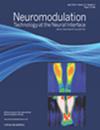Low-Intensity Ultrasound Tibial Nerve Stimulation Suppresses Bladder Activity in Rats
IF 3.2
3区 医学
Q2 CLINICAL NEUROLOGY
引用次数: 0
Abstract
Background and Objective
Noninvasive neuromodulation, particularly through low-intensity ultrasound, holds promise in the fields of neuroscience and neuro-engineering. Ultrasound can stimulate the central nervous system to treat neurologic disorders of the brain and activate peripheral nerve activity. The aim of this study is to investigate the inhibitory effect of low-intensity ultrasonic tibial nerve stimulation on both the physiological state and the overactive bladder (OAB) model in rats.
Materials and Methods
A total of 28 female Sprague-Dawley rats were used in this study. Continuous transurethral instillation of 0.9% normal saline into the bladder was initially performed to stimulate physiological bladder activity. Subsequently, a solution containing 0.3% acetic acid dissolved in saline was instilled to induce rat models of OAB. The study comprised two phases: initial observation of bladder response to low-intensity ultrasound (1 MHz, 1 W/cm2, 50% duty cycle) in seven rats; subsequent exploration of ultrasound frequency (3 MHz) and intensity (2 W/cm2 and 3 W/cm2) effects in 21 rats. The intercontraction intervals (ICIs) were the primary outcome measure. Histologic analysis of tibial nerves and surrounding muscle tissues determined safe ultrasound parameters.
Results
Low-intensity ultrasound tibial nerve stimulation significantly inhibited normal and OAB activity. Ultrasound stimulation at 1 MHz, 1 W/cm2, with a 50% duty cycle significantly prolonged the ICI in both normal (p < 0.0001) and OAB rats (p < 0.01), as did transitioning to a 3 MHz frequency (p = 0.001 for normal rats; p < 0.01 for OAB rats). Similarly, at an intensity of 2 W/cm2 and 1 MHz frequency with a 50% duty cycle, ultrasound stimulation significantly prolonged the ICI in both normal (p < 0.01) and OAB rats (p < 0.005). Furthermore, switching to a 3 W/cm2 ultrasound intensity also significantly extended the ICI in both normal (p < 0.05) and OAB rats (p = 0.01). However, after different ultrasound intensities and frequencies, there was no statistical difference in ICI ratios (preultrasound stimulation vs postultrasound stimulation/preultrasound stimulation ∗ 100%) in all rats (p > 0.05). Low-intensity ultrasound tibial nerve stimulation did not influence baseline pressure, threshold pressure, or maximum pressure. In addition, a latency period in bladder reflex inhibition was induced by low-intensity ultrasound tibial nerve stimulation in some rats. Histologic analysis indicated no evident nerve or muscle tissue damage or abnormalities.
Conclusions
This study confirmed the potential of transcutaneous ultrasound tibial nerve stimulation to improve bladder function. According to the findings, the ultrasonic intensities ranging from 1 to 3 W/cm2 and frequencies of 1 MHz and 3 MHz are both feasible and safe treatment parameters. This study portended the promise of low-intensity ultrasound tibial nerve stimulation as a treatment for OAB and provides a basis and reference for future clinical applications.
低强度超声波胫神经刺激可抑制大鼠的膀胱活动
背景和目的:无创神经调控,特别是通过低强度超声波,在神经科学和神经工程领域大有可为。超声波可以刺激中枢神经系统,治疗脑神经疾病,激活周围神经活动。本研究旨在探讨低强度超声波胫神经刺激对大鼠生理状态和膀胱过度活动症(OAB)模型的抑制作用:本研究共使用了 28 只雌性 Sprague-Dawley 大鼠。首先向膀胱持续经尿道灌注 0.9% 生理盐水,以刺激膀胱的生理活动。随后,灌入溶于生理盐水的含 0.3% 乙酸的溶液,诱导大鼠建立 OAB 模型。该研究包括两个阶段:首先观察 7 只大鼠对低强度超声波(1 MHz、1 W/cm2、50% 占空比)的膀胱反应;随后探讨 21 只大鼠对超声波频率(3 MHz)和强度(2 W/cm2 和 3 W/cm2)的影响。收缩间期(ICIs)是主要的结果测量指标。胫神经和周围肌肉组织的组织学分析确定了安全超声参数:结果:低强度超声胫神经刺激能显著抑制正常活动和 OAB 活动。频率为 1 MHz、功率为 1 W/cm2 且占空比为 50%的超声波刺激可明显延长正常大鼠(p < 0.0001)和 OAB 大鼠(p < 0.01)的 ICI,过渡到 3 MHz 频率也是如此(正常大鼠 p = 0.001;OAB 大鼠 p < 0.01)。同样,在强度为 2 W/cm2 和频率为 1 MHz 且占空比为 50%的情况下,超声刺激可显著延长正常大鼠(p < 0.01)和 OAB 大鼠(p < 0.005)的 ICI。此外,改用 3 W/cm2 超声波强度也能明显延长正常大鼠(p < 0.05)和 OAB 大鼠(p = 0.01)的 ICI。然而,在不同的超声强度和频率下,所有大鼠的 ICI 比率(超声刺激前与超声刺激后/超声刺激前 ∗ 100%)均无统计学差异(p > 0.05)。低强度超声波胫神经刺激不会影响基线压力、阈值压力或最大压力。此外,低强度超声胫神经刺激在一些大鼠中诱发了膀胱反射抑制的潜伏期。组织学分析表明,神经或肌肉组织没有明显损伤或异常:本研究证实了经皮超声胫神经刺激改善膀胱功能的潜力。研究结果表明,1 至 3 W/cm2 的超声波强度以及 1 MHz 和 3 MHz 的频率都是可行且安全的治疗参数。这项研究预示着低强度超声胫神经刺激治疗OAB的前景,为今后的临床应用提供了依据和参考。
本文章由计算机程序翻译,如有差异,请以英文原文为准。
求助全文
约1分钟内获得全文
求助全文
来源期刊

Neuromodulation
医学-临床神经学
CiteScore
6.40
自引率
3.60%
发文量
978
审稿时长
54 days
期刊介绍:
Neuromodulation: Technology at the Neural Interface is the preeminent journal in the area of neuromodulation, providing our readership with the state of the art clinical, translational, and basic science research in the field. For clinicians, engineers, scientists and members of the biotechnology industry alike, Neuromodulation provides timely and rigorously peer-reviewed articles on the technology, science, and clinical application of devices that interface with the nervous system to treat disease and improve function.
 求助内容:
求助内容: 应助结果提醒方式:
应助结果提醒方式:


